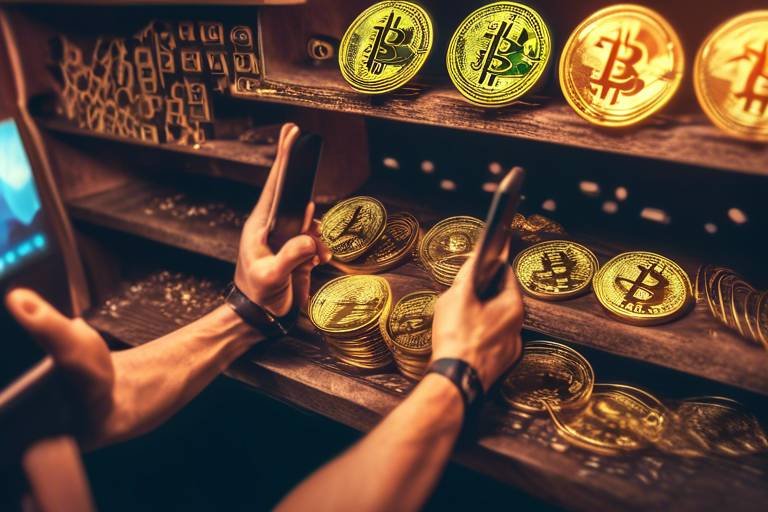Understanding Liquidity Mining and Its Benefits
In the ever-evolving world of decentralized finance (DeFi), liquidity mining has emerged as a revolutionary concept, enticing both seasoned investors and newcomers alike. But what exactly is liquidity mining? At its core, liquidity mining is the process whereby users provide liquidity to decentralized platforms in exchange for rewards, often in the form of tokens. This not only enhances the platform's liquidity but also boosts its overall usability. Imagine being a gardener who nurtures a flourishing garden; the more you tend to it, the more vibrant and fruitful it becomes. Similarly, liquidity mining cultivates the DeFi ecosystem, allowing it to grow and thrive.
As we dive deeper into this fascinating topic, we’ll explore the mechanisms behind liquidity mining, the role of smart contracts, the various types of rewards available, and the risks associated with this investment strategy. By the end of this journey, you'll have a comprehensive understanding of how liquidity mining works and how it can benefit you in the world of DeFi.
Liquidity mining, in simple terms, refers to the act of providing liquidity to a decentralized platform, such as a decentralized exchange (DEX) or lending protocol, in return for rewards. These rewards typically come in the form of tokens, which can be traded or held for potential future gains. By participating in liquidity mining, users contribute to the liquidity pool, thus enabling traders to buy and sell assets without significant price slippage. Think of it as being part of a team where everyone contributes to a common goal; your contribution not only benefits you but also helps the entire ecosystem flourish.
The mechanics of liquidity mining are relatively straightforward. Users deposit their assets into a liquidity pool, which is then utilized by traders to execute transactions. As liquidity providers, these users earn rewards proportional to their contribution to the pool. This process is akin to a lending library: the more books you donate, the more borrowing privileges you earn. In the world of DeFi, the more liquidity you provide, the greater your potential rewards.
Smart contracts play a pivotal role in the liquidity mining process. These self-executing contracts automate transactions, ensuring that liquidity providers receive their rewards without the need for intermediaries. This not only enhances security but also increases efficiency, allowing for seamless interactions within the decentralized ecosystem. Imagine a vending machine: you insert your money, select your item, and the machine delivers it without any human intervention. Smart contracts operate in a similar fashion, executing transactions based on predefined rules.
One of the significant advantages of smart contracts is their ability to reduce the risk of human error and fraud. They ensure that the terms of liquidity mining agreements are executed precisely as coded, providing peace of mind to participants. This level of automation and security can transform how we engage with financial services, making them more reliable and trustworthy.
However, it’s essential to acknowledge that smart contracts are not without their challenges. They can harbor vulnerabilities and bugs, which could potentially expose users to risks. Therefore, conducting thorough audits and choosing reputable platforms for liquidity mining are crucial steps for participants to safeguard their investments. Just like you wouldn’t buy a used car without a mechanic’s inspection, it’s vital to ensure that the smart contracts you engage with are secure and reliable.
Participants in liquidity mining can earn a variety of rewards, which can significantly enhance their overall returns. These rewards may include:
- Native Tokens: Tokens specific to the platform, which can often appreciate in value.
- Governance Tokens: Tokens that provide holders with voting rights on platform decisions, allowing them to influence the future direction of the project.
- Transaction Fees: A share of the fees generated by trades executed on the platform.
Each of these reward types brings unique benefits and risks, making it essential for liquidity miners to understand their options fully.
While liquidity mining presents enticing opportunities for rewards, it is also accompanied by certain risks. These include impermanent loss, vulnerabilities in smart contracts, and the ever-present threat of market volatility. Understanding these risks is crucial for anyone looking to engage in liquidity mining.
Impermanent loss occurs when the value of the assets you’ve deposited into a liquidity pool fluctuates significantly. This can lead to lower returns compared to simply holding the assets. For liquidity providers, it’s essential to grasp this concept, as it can dramatically impact your overall profitability. Picture yourself at a carnival: you invest in a game to win a prize, but if the game changes unexpectedly, your chances of winning diminish. Similarly, the value of your deposited assets can change, affecting your returns.
The cryptocurrency market is notorious for its volatility, which can significantly influence the profitability of liquidity mining. Prices can swing dramatically in a short period, making it vital for participants to stay informed about market trends and adjust their strategies accordingly. Think of it as navigating a turbulent sea; if you don’t keep an eye on the weather, you might find yourself in choppy waters without a life raft.
To maximize returns and minimize risks in liquidity mining, it’s essential to adopt best practices. These include thoroughly researching platforms, diversifying investments, and staying updated on market conditions and protocol developments. By doing so, you can position yourself for success in this exciting financial frontier.
Selecting a reputable and secure platform is vital for successful liquidity mining. The right choice can significantly impact the safety of your funds and your potential for earning rewards. Just like choosing a trustworthy bank, it’s essential to do your homework before diving in.
Diversifying your liquidity provision across multiple pools or assets can help mitigate risks associated with impermanent loss and market volatility. This strategy allows liquidity miners to achieve more stable returns, akin to spreading your investments across various stocks rather than putting all your eggs in one basket.
What is liquidity mining?
Liquidity mining is the process of providing liquidity to decentralized platforms in exchange for rewards, typically in the form of tokens.
What are the risks of liquidity mining?
The risks include impermanent loss, smart contract vulnerabilities, and market volatility.
How can I maximize my returns in liquidity mining?
To maximize returns, research platforms thoroughly, diversify your investments, and stay updated on market trends.

What is Liquidity Mining?
Liquidity mining is a fascinating concept that has emerged from the decentralized finance (DeFi) movement, and it's transforming the way we think about investing and earning in the crypto space. In simple terms, liquidity mining refers to the process where users, often referred to as liquidity providers, supply their digital assets to a decentralized platform. In return for their contribution, they earn rewards, typically in the form of tokens. This reciprocal relationship not only enhances the platform's liquidity but also improves its overall usability. Imagine a bustling marketplace where vendors (liquidity providers) bring their goods (assets) to sell, and in return, they earn a share of the profits (rewards) for their participation.
The main goal of liquidity mining is to ensure that there are enough assets available for traders who want to buy or sell without causing significant price fluctuations. By providing liquidity, users help create a more stable and efficient market. What’s more, liquidity mining can be seen as a win-win situation: the platform gets the liquidity it needs to operate smoothly, while users can earn passive income from their assets. This process has gained immense popularity, especially among those looking to maximize their returns in the DeFi ecosystem.
To give you a clearer picture, let's break down the key components of liquidity mining:
- Liquidity Pools: These are collections of funds locked in smart contracts, allowing traders to exchange assets seamlessly.
- Rewards: Participants earn rewards in various forms, which can include native tokens of the platform, governance tokens, or even a portion of transaction fees.
- Decentralization: Unlike traditional finance, liquidity mining operates on a peer-to-peer basis, removing intermediaries and allowing users to interact directly.
Overall, liquidity mining is a revolutionary approach that not only incentivizes users to participate actively in the DeFi ecosystem but also helps create a robust financial infrastructure. As we delve deeper into the mechanics of liquidity mining, you'll discover how it works, its benefits, and the potential risks involved, enabling you to make informed decisions in your financial journey.

How Does Liquidity Mining Work?
Liquidity mining is a fascinating and dynamic process that fuels the decentralized finance (DeFi) ecosystem. At its core, it involves users, often referred to as liquidity providers, depositing their assets into a liquidity pool. This pool acts like a communal resource that traders can draw from to execute their transactions. Think of it as a bustling marketplace where everyone contributes goods, making it easier for buyers and sellers to meet their needs. In return for their contribution, liquidity providers earn rewards, typically in the form of tokens. This setup not only enhances the liquidity of the platform but also incentivizes users to actively participate.
To better understand how liquidity mining works, let’s break down the process:
- Deposit Assets: Users start by depositing their cryptocurrencies into a designated liquidity pool. This could be anything from Ethereum to stablecoins, depending on the platform.
- Facilitate Trading: The deposited assets are then available for traders to use. These traders can swap tokens, providing them with the flexibility they need to capitalize on market opportunities.
- Earn Rewards: As traders utilize the liquidity pool, the liquidity providers earn rewards proportional to their contribution. These rewards can come in various forms, including native tokens of the platform, governance tokens, or even a share of the transaction fees generated by the trades.
It's important to note that the rewards are not fixed; they fluctuate based on the volume of trades and the overall activity within the liquidity pool. This creates an exciting, albeit sometimes unpredictable, environment for liquidity providers. The more active the trading, the higher the potential rewards for those providing liquidity.
Moreover, liquidity mining is powered by smart contracts. These self-executing contracts automate the entire process, ensuring that transactions are executed seamlessly and that liquidity providers receive their rewards without the need for intermediaries. This not only enhances security but also boosts efficiency, allowing for a smoother experience for all parties involved.
However, while the mechanics of liquidity mining may seem straightforward, participants should remain vigilant. The decentralized nature of these platforms means that users must do their due diligence to understand the risks involved, including potential vulnerabilities in smart contracts and the implications of market volatility. In the next sections, we will delve deeper into the benefits and challenges of liquidity mining, as well as best practices to maximize returns.
- What is the primary goal of liquidity mining?
Liquidity mining aims to enhance the liquidity of decentralized platforms while rewarding users for their contributions. - Are there any risks associated with liquidity mining?
Yes, risks include impermanent loss, smart contract vulnerabilities, and market volatility. - How can I choose the right platform for liquidity mining?
Research the platform's reputation, security measures, and the types of rewards offered before committing your assets.

The Role of Smart Contracts
In the world of liquidity mining, smart contracts play a pivotal role that cannot be overstated. These self-executing contracts with the terms of the agreement directly written into code are the backbone of decentralized finance (DeFi) platforms. But what exactly do they do? Well, they automate the entire process of liquidity provision, ensuring that transactions occur seamlessly and without the need for intermediaries. Imagine a vending machine: you insert money, select your item, and voila! The machine delivers your snack without needing a cashier. Smart contracts function similarly, providing a transparent and efficient way to facilitate transactions and reward liquidity providers.
When users deposit their assets into a liquidity pool, smart contracts automatically manage these assets, allowing traders to access them for their transactions. This automation not only saves time but also enhances security. Since smart contracts operate on the blockchain, the rules are enforced by the network itself, significantly reducing the risk of fraud or manipulation. In essence, they act as a trustless intermediary, ensuring that all parties involved in liquidity mining can participate with confidence.
Furthermore, the rewards for liquidity providers are calculated and distributed by these smart contracts. This means that as a liquidity provider, you don’t have to worry about manually tracking your earnings or waiting for someone to process your rewards. Instead, you can focus on your investment strategy, knowing that the smart contract will handle the nitty-gritty details. The result? A more streamlined and user-friendly experience for participants in the DeFi ecosystem.
However, while smart contracts offer numerous advantages, they are not without their challenges. Vulnerabilities and bugs can exist within the code, which can lead to significant risks. Therefore, it is crucial for users to conduct thorough audits of smart contracts before committing their assets. Just like you wouldn’t buy a used car without checking its history, you shouldn’t engage in liquidity mining without understanding the smart contracts involved.
In summary, smart contracts are the unsung heroes of liquidity mining. They automate transactions, ensure security, and provide a level of efficiency that traditional finance simply cannot match. As the DeFi space continues to evolve, understanding the role of smart contracts will be essential for anyone looking to dive into liquidity mining.

Benefits of Smart Contracts
This article explores the concept of liquidity mining, its mechanisms, and the various benefits it offers to participants in decentralized finance (DeFi) ecosystems.
Liquidity mining refers to the process where users provide liquidity to a decentralized platform in exchange for rewards, typically in the form of tokens, enhancing the platform's liquidity and usability.
The mechanics of liquidity mining involve depositing assets into a liquidity pool, allowing traders to utilize these assets while the liquidity provider earns rewards proportional to their contribution.
Smart contracts automate transactions and ensure that liquidity providers receive their rewards without intermediaries, enhancing security and efficiency in liquidity mining processes.
Smart contracts are a game-changer in the world of liquidity mining. They provide a level of trust and transparency that traditional systems often lack. By eliminating the need for intermediaries, smart contracts significantly reduce the chances of fraud and human error. Imagine a vending machine that dispenses your favorite snack as soon as you insert the correct amount of money—this is how smart contracts operate, executing transactions automatically when conditions are met.
Here are some key benefits of smart contracts in liquidity mining:
- Automation: Smart contracts automatically execute transactions, which means liquidity providers don’t have to wait for manual processing. This leads to faster and more efficient operations.
- Security: The code that underlies smart contracts is stored on the blockchain, making it immutable and secure. Once deployed, the terms of the contract cannot be changed, which protects participants from potential manipulation.
- Transparency: All transactions executed through smart contracts are publicly recorded on the blockchain. This transparency helps build trust among participants, as they can independently verify the execution of transactions.
- Cost Efficiency: By cutting out intermediaries, smart contracts can reduce transaction fees, making liquidity mining more profitable for participants.
However, while these benefits are substantial, it’s essential to note that the effectiveness of smart contracts largely depends on the quality of their code. A poorly written smart contract can lead to vulnerabilities that may be exploited, resulting in loss of funds. Therefore, the importance of conducting thorough audits and choosing reputable platforms cannot be overstated.
While liquidity mining offers potential rewards, it also comes with risks such as impermanent loss, smart contract vulnerabilities, and market volatility that participants should consider before engaging.
Impermanent loss occurs when the value of deposited assets fluctuates, potentially leading to lower returns compared to simply holding the assets, making it a critical factor for liquidity providers to understand.
The inherent volatility of cryptocurrencies can affect the profitability of liquidity mining, making it essential for participants to stay informed about market trends and adjust their strategies accordingly.
To maximize returns and minimize risks, liquidity miners should research platforms thoroughly, diversify their investments, and stay updated on market conditions and protocol developments.
Selecting a reputable and secure platform is vital for successful liquidity mining, as it can significantly impact the safety of funds and the potential for earning rewards.
Diversifying liquidity provision across multiple pools or assets can mitigate risks associated with impermanent loss and market volatility, helping liquidity miners achieve more stable returns.
Q: What is liquidity mining?
A: Liquidity mining is the process where users provide liquidity to decentralized platforms in exchange for rewards, typically in the form of tokens.
Q: How do smart contracts work in liquidity mining?
A: Smart contracts automate transactions, ensuring liquidity providers receive their rewards without intermediaries, enhancing security and efficiency.
Q: What are the risks of liquidity mining?
A: Risks include impermanent loss, vulnerabilities in smart contracts, and market volatility that can affect profits.
Q: How can I minimize risks in liquidity mining?
A: Research platforms thoroughly, diversify your investments, and stay updated on market conditions and protocol developments.

Challenges with Smart Contracts
While smart contracts are heralded as a revolutionary tool in the world of liquidity mining, they are not without their challenges. One of the primary concerns is the potential for vulnerabilities and bugs in the code. Just like a chain is only as strong as its weakest link, a single flaw in a smart contract can lead to significant financial losses for liquidity providers. This is particularly alarming given that once a smart contract is deployed on the blockchain, it cannot be altered easily.
Moreover, the complexity of smart contracts can create a steep learning curve for new users. Many participants may not fully understand how these contracts work, which could lead to mistakes when interacting with them. Imagine trying to navigate a maze without a map; without proper knowledge, you might find yourself lost or worse, trapped in a financial commitment that you didn't intend to make.
Another challenge is the risk of hacks. Despite their automated nature, smart contracts can be targets for malicious actors looking to exploit any weaknesses. High-profile hacks have occurred in the past, highlighting the importance of conducting thorough audits before engaging with any liquidity mining platform. Even with audits, there’s no guarantee that a contract is entirely free from vulnerabilities, much like how a safety net can still have holes.
Finally, the lack of regulation surrounding smart contracts can lead to uncertainty. As the DeFi space evolves, regulations are still catching up, leaving users exposed to potential legal and financial ramifications. This uncertainty can deter potential liquidity providers from participating, as they may feel uneasy about the security and legitimacy of their investments.
In summary, while smart contracts offer numerous advantages in the liquidity mining process, it is crucial for participants to be aware of these challenges. By understanding the risks and taking proactive measures, such as choosing reputable platforms and conducting thorough research, liquidity miners can navigate the complexities of smart contracts more effectively.
- What is liquidity mining? Liquidity mining is the process of providing liquidity to a decentralized platform in exchange for rewards, usually in the form of tokens.
- What are the risks associated with liquidity mining? Risks include impermanent loss, smart contract vulnerabilities, and market volatility.
- How can I mitigate risks in liquidity mining? Diversifying investments, choosing reputable platforms, and staying informed about market trends can help mitigate risks.
- What are smart contracts? Smart contracts are self-executing contracts with the terms of the agreement directly written into code, allowing for automated transactions without intermediaries.

Types of Liquidity Mining Rewards
When diving into the world of liquidity mining, one of the most exciting aspects is the variety of rewards that participants can earn. These rewards not only enhance the overall experience but also significantly boost the potential returns for those who provide liquidity. So, what exactly can you expect to receive as a liquidity miner? Let's break it down.
First and foremost, many platforms offer native tokens as a reward for providing liquidity. These are the tokens that belong to the platform itself. For instance, if you're providing liquidity to a decentralized exchange (DEX), you might earn the platform's token simply for contributing your assets. This is a fantastic way to accumulate tokens that may appreciate in value over time, especially if the platform gains popularity and usage.
In addition to native tokens, liquidity miners often receive governance tokens. These tokens grant holders voting rights on important decisions regarding the platform's future, such as changes to protocol rules or how funds are allocated. This not only gives liquidity providers a stake in the platform's governance but also allows them to influence its direction. It’s akin to having a say in the boardroom of a company you’ve invested in!
Another rewarding aspect of liquidity mining is the potential to earn transaction fees. Every time a trade occurs on the platform, a small fee is typically charged. These fees are then distributed among liquidity providers based on their contribution to the liquidity pool. So, the more liquidity you provide, the more fees you can earn. This mechanism is similar to earning interest on a savings account, but with the added thrill of being part of a dynamic financial ecosystem.
To give you a clearer picture, here's a simple table summarizing the types of rewards you can earn through liquidity mining:
| Type of Reward | Description |
|---|---|
| Native Tokens | Tokens specific to the platform, often with potential for appreciation. |
| Governance Tokens | Tokens that provide voting rights on platform decisions. |
| Transaction Fees | Fees collected from trades, distributed to liquidity providers. |
As you can see, the rewards for liquidity mining are multifaceted, offering both immediate financial incentives and long-term benefits through governance participation. However, it’s essential to consider the risks associated with liquidity mining, as the potential for loss exists alongside these exciting rewards. Balancing the quest for rewards with a thorough understanding of the associated risks is key to a successful liquidity mining experience.
- What is liquidity mining? Liquidity mining is the process of providing liquidity to a decentralized platform in exchange for rewards.
- What types of rewards can I earn? You can earn native tokens, governance tokens, and transaction fees.
- Are there risks involved in liquidity mining? Yes, risks include impermanent loss, smart contract vulnerabilities, and market volatility.
- How can I maximize my returns? Research platforms, diversify investments, and stay updated on market conditions.

Risks Associated with Liquidity Mining
While liquidity mining can be a lucrative venture, it’s essential to recognize that it doesn’t come without its share of risks. Engaging in liquidity mining is akin to navigating a rollercoaster; there are thrilling highs but also potential drops that can leave you feeling uneasy. One of the primary risks is impermanent loss, which occurs when the value of the assets you’ve deposited into a liquidity pool fluctuates. This fluctuation can lead to a situation where, upon withdrawal, the total value of your assets is less than if you had simply held onto them. It’s a bit like investing in a stock that suddenly drops in value; you’re left wondering if you should have just kept your money in a savings account.
Another significant risk is tied to smart contract vulnerabilities. Smart contracts, while designed to automate and secure transactions, can have bugs or vulnerabilities that malicious actors may exploit. Imagine leaving your front door unlocked; even if you trust your neighborhood, there’s always a chance that someone could take advantage of that oversight. Therefore, it’s crucial to conduct thorough audits and choose reputable platforms to minimize this risk.
Additionally, market volatility plays a critical role in the risks associated with liquidity mining. The cryptocurrency market is notorious for its price swings, and these fluctuations can dramatically impact the profitability of your liquidity mining efforts. For instance, if you provide liquidity to a pool during a market downturn, you could find your returns significantly diminished. Staying informed about market trends and adjusting your strategies accordingly can help mitigate this risk, but it requires constant vigilance.
To summarize, here are some key risks to keep in mind:
- Impermanent Loss: The potential decrease in value of your assets compared to simply holding them.
- Smart Contract Vulnerabilities: Bugs or exploits in the code that could lead to loss of funds.
- Market Volatility: Fluctuations in cryptocurrency prices that can affect your returns.
In conclusion, while liquidity mining presents exciting opportunities for earning rewards, it’s vital to approach it with caution. Understanding these risks can help you make informed decisions, ultimately leading to a more successful and sustainable liquidity mining experience.
1. What is liquidity mining?
Liquidity mining is the process of providing liquidity to decentralized finance platforms in exchange for rewards, usually in the form of tokens.
2. What are the main risks of liquidity mining?
The main risks include impermanent loss, smart contract vulnerabilities, and market volatility.
3. How can I mitigate risks in liquidity mining?
You can mitigate risks by researching platforms, diversifying your investments, and staying updated on market trends.
4. Is liquidity mining suitable for beginners?
While liquidity mining can be profitable, it requires a good understanding of the risks involved. Beginners should educate themselves and possibly start with smaller investments.

Understanding Impermanent Loss
When diving into the world of liquidity mining, one term that often raises eyebrows is impermanent loss. This phenomenon is crucial for anyone considering becoming a liquidity provider. In simple terms, impermanent loss refers to the temporary loss of funds experienced by liquidity providers due to the volatility of the assets they have deposited into a liquidity pool. Imagine you’ve got a basket of apples and oranges. If the price of oranges skyrockets while the price of apples remains stable, and you decide to sell your basket, you might end up with fewer oranges than if you had just held onto them. This is akin to what happens in liquidity mining when asset prices fluctuate.
To put it into perspective, let’s say you provide liquidity to a pool containing ETH and a stablecoin like USDC. If the price of ETH rises significantly after you deposit it, the automated market maker (AMM) will adjust the ratio of ETH to USDC in the pool to maintain a balanced value. Consequently, you might end up with less ETH than you initially deposited, even though the total value of your assets in the pool might have increased. This can lead to a situation where, if you had simply held onto your ETH, you would have had a higher value than if you had participated in liquidity mining.
Here are a few key points to understand about impermanent loss:
- Temporary Nature: As the name suggests, impermanent loss is not permanent. If the prices of the assets return to their original state, the loss can be mitigated.
- Magnitude of Loss: The extent of impermanent loss is directly related to the volatility of the assets in the pool. The more volatile the assets, the higher the risk of impermanent loss.
- Liquidity Pool Dynamics: The way liquidity pools are structured can also influence how impermanent loss affects your investment. Pools that contain stablecoins generally experience lower impermanent loss compared to those with highly volatile assets.
Ultimately, understanding impermanent loss is essential for anyone looking to engage in liquidity mining. It’s not just about the potential rewards; it’s also about navigating the risks that come with providing liquidity to decentralized platforms. By being aware of this phenomenon, you can make more informed decisions and potentially devise strategies to mitigate its impact.
What is impermanent loss?
Impermanent loss is the temporary loss of funds that liquidity providers experience due to the price volatility of the assets in a liquidity pool.
Can impermanent loss be avoided?
While it cannot be entirely avoided, you can minimize its impact by choosing less volatile assets or by diversifying your liquidity provision across multiple pools.
Is impermanent loss permanent?
No, impermanent loss is not permanent. If the prices of the assets return to their original levels, the loss can be mitigated.
How can I calculate impermanent loss?
There are several online calculators available that can help you estimate impermanent loss based on the price changes of the assets you have deposited in a liquidity pool.

Market Volatility Considerations
When diving into the world of liquidity mining, one cannot overlook the impact of market volatility. Cryptocurrencies are notorious for their price swings, and these fluctuations can significantly affect the profitability of your liquidity mining endeavors. Imagine riding a roller coaster—one moment you’re at the peak, exhilarated by the view, and the next, you’re plummeting down, your stomach in knots. This is akin to the experience of a liquidity provider when the market takes a sudden turn.
Market volatility can lead to impermanent loss, which occurs when the value of your deposited assets changes unfavorably compared to simply holding them. For instance, if you provide liquidity for a trading pair and the price of one asset skyrockets while the other plummets, the overall value of your liquidity pool may decrease, leading to potential losses. It's essential to grasp this concept fully, as it’s a critical factor affecting your returns.
Moreover, the volatile nature of cryptocurrencies can create a ripple effect on the liquidity pools themselves. High volatility can lead to increased trading activity, which might seem beneficial at first glance. However, it can also result in rapid changes in asset prices, making it challenging to predict future returns. As a liquidity miner, you must be prepared for these scenarios and consider employing strategies to manage your exposure to risk.
To navigate the choppy waters of market volatility effectively, here are some considerations:
- Stay Informed: Regularly monitor market trends and news that could impact asset prices. Knowledge is your best ally in making informed decisions.
- Utilize Analytics Tools: Leverage analytics platforms to track price movements and liquidity metrics. These tools can provide insights that help you adjust your strategies proactively.
- Have an Exit Strategy: Define clear parameters for when to withdraw your liquidity. Setting limits can help you minimize losses during turbulent market conditions.
In conclusion, understanding market volatility is crucial for anyone involved in liquidity mining. By staying informed and employing strategic measures, you can better navigate the unpredictable nature of cryptocurrency markets. Remember, while the potential for rewards is enticing, being prepared for the risks is equally important to ensure a successful liquidity mining experience.
- What is liquidity mining? Liquidity mining is the process of providing liquidity to a decentralized platform in exchange for rewards, often in the form of tokens.
- What are the risks of liquidity mining? Risks include impermanent loss, smart contract vulnerabilities, and market volatility.
- How can I minimize risks while liquidity mining? Research platforms, diversify investments, and stay informed about market conditions.
- What types of rewards can I earn from liquidity mining? Rewards can include native tokens, governance tokens, and transaction fees.

Best Practices for Successful Liquidity Mining
When it comes to liquidity mining, having a solid strategy can mean the difference between success and disappointment. Just like any investment, diving in without a plan can lead to unforeseen pitfalls. So, what are the best practices to ensure you're making the most out of your liquidity mining experience? Let’s break it down!
First and foremost, research is key. Before you commit your assets to any liquidity pool, take the time to understand the platform you’re considering. Look for user reviews, check their security measures, and see if they have a history of successful operations. A platform with a good track record is like a sturdy ship; it’s less likely to sink in turbulent waters. You wouldn’t want to invest in a platform that has a reputation for being unreliable or insecure, right?
Next up, diversification is your friend. Just as you wouldn’t put all your eggs in one basket, you shouldn’t concentrate all your liquidity in a single pool. By spreading your investments across multiple pools or different assets, you can mitigate risks associated with impermanent loss and market volatility. Think of it as planting a garden; if one type of flower doesn’t bloom, you still have others thriving!
It's also crucial to stay updated on market conditions and protocol developments. The crypto landscape is constantly changing, and what worked yesterday might not work tomorrow. Subscribing to newsletters, following relevant social media accounts, and engaging in community forums can keep you informed about trends and potential risks. After all, knowledge is power, and in the world of liquidity mining, being informed can lead to more profitable decisions.
Additionally, understanding the specific mechanics of the liquidity pools you are entering is vital. Each pool may have different rules regarding rewards, fees, and withdrawal conditions. For example, some pools might offer higher rewards but come with higher risk, while others may be more stable but offer lower returns. Make sure you read the fine print and know what you're signing up for. It’s like reading the terms and conditions before clicking ‘I agree’—always a smart move!
Finally, consider utilizing tools and analytics platforms that can help you track your investments. Just as a captain uses a compass to navigate the seas, these tools can guide you through the often turbulent waters of DeFi. They can provide insights into your performance, alert you to significant changes in the market, and help you make informed decisions about when to enter or exit a liquidity pool.
In summary, successful liquidity mining requires a blend of thorough research, diversification, continuous learning, and the use of analytical tools. By following these best practices, you can position yourself for success in the ever-evolving world of decentralized finance.
What is liquidity mining?
Liquidity mining is the process where users provide liquidity to a decentralized platform in exchange for rewards, typically in the form of tokens.
What are the risks associated with liquidity mining?
Risks include impermanent loss, smart contract vulnerabilities, and market volatility that can affect your returns.
How can I reduce the risks of impermanent loss?
You can reduce impermanent loss by diversifying your investments across different pools and assets.
What should I look for in a liquidity mining platform?
Look for platforms with a good reputation, strong security measures, and transparent operations.
How often should I check my liquidity mining investments?
It's advisable to stay updated regularly, as market conditions can change quickly. Monitoring your investments weekly can help you make timely decisions.

Choosing the Right Platform
This article explores the concept of liquidity mining, its mechanisms, and the various benefits it offers to participants in decentralized finance (DeFi) ecosystems.
Liquidity mining refers to the process where users provide liquidity to a decentralized platform in exchange for rewards, typically in the form of tokens, enhancing the platform's liquidity and usability.
The mechanics of liquidity mining involve depositing assets into a liquidity pool, allowing traders to utilize these assets while the liquidity provider earns rewards proportional to their contribution.
Smart contracts automate transactions and ensure that liquidity providers receive their rewards without intermediaries, enhancing security and efficiency in liquidity mining processes.
Smart contracts reduce the risk of human error and fraud, ensuring that the terms of liquidity mining agreements are executed precisely as coded, providing peace of mind to participants.
Despite their advantages, smart contracts can have vulnerabilities and bugs, making it crucial for users to conduct thorough audits and choose reputable platforms for liquidity mining.
Participants can receive various types of rewards, including native tokens, governance tokens, and transaction fees, which can significantly enhance their overall returns from liquidity mining.
While liquidity mining offers potential rewards, it also comes with risks such as impermanent loss, smart contract vulnerabilities, and market volatility that participants should consider before engaging.
Impermanent loss occurs when the value of deposited assets fluctuates, potentially leading to lower returns compared to simply holding the assets, making it a critical factor for liquidity providers to understand.
The inherent volatility of cryptocurrencies can affect the profitability of liquidity mining, making it essential for participants to stay informed about market trends and adjust their strategies accordingly.
To maximize returns and minimize risks, liquidity miners should research platforms thoroughly, diversify their investments, and stay updated on market conditions and protocol developments.
When it comes to liquidity mining, can make all the difference between success and failure. With the plethora of options available in the decentralized finance (DeFi) space, it can feel overwhelming to pinpoint which platform aligns with your goals and offers a secure environment for your investments. Here are some key factors to consider:
- Security: Look for platforms that have undergone rigorous security audits and have a transparent track record. A platform with a history of hacks or security breaches should raise red flags.
- User Experience: The interface should be intuitive and user-friendly. If you're struggling to navigate the platform, you might miss out on important features or updates.
- Liquidity Pools: Investigate the types of liquidity pools available. Some platforms may offer more lucrative rewards but come with higher risks. Balance your risk appetite with the potential returns.
- Community and Support: A strong community and responsive support team can be invaluable. Engaging with other users can provide insights and tips that enhance your liquidity mining experience.
In addition to these factors, it’s wise to keep an eye on the platform's governance model. Platforms that allow token holders to participate in decision-making processes often foster a more engaged community, which can lead to better overall platform performance. Furthermore, consider the reward structure of the platform. Some platforms offer higher initial rewards to attract users, while others may provide more stable long-term incentives.
Ultimately, the right platform for you will depend on your individual goals and risk tolerance. Taking the time to research and evaluate your options can significantly enhance your liquidity mining journey, allowing you to reap the rewards while minimizing potential pitfalls.
Q1: What is liquidity mining?
A1: Liquidity mining is the process of providing liquidity to a decentralized platform in exchange for rewards, usually in the form of tokens.
Q2: What are the risks involved in liquidity mining?
A2: Risks include impermanent loss, smart contract vulnerabilities, and market volatility. It's essential to understand these risks before participating.
Q3: How can I choose the right liquidity mining platform?
A3: Look for factors like security, user experience, liquidity pools, community support, and the platform's governance model.
Q4: What types of rewards can I earn through liquidity mining?
A4: Participants can earn native tokens, governance tokens, and a share of transaction fees, which can significantly enhance overall returns.

Diversification Strategies
Diversification is a crucial strategy for liquidity miners looking to enhance their returns while minimizing risks. By spreading investments across multiple liquidity pools or assets, miners can mitigate potential losses associated with impermanent loss and market volatility. Think of it like a balanced diet; just as consuming a variety of foods can lead to better health, diversifying your investments can lead to a more stable financial outcome.
When it comes to diversification, there are several approaches that liquidity miners can take. For instance, they might consider allocating funds across different types of liquidity pools. Some pools may offer higher rewards but come with increased risk, while others might provide more stable returns with lower rewards. By balancing these factors, miners can tailor their strategies to suit their risk tolerance and investment goals.
Another effective strategy is to diversify across various assets. In the world of cryptocurrencies, different tokens can behave quite differently based on market conditions. By investing in a mix of established coins and emerging tokens, liquidity miners can capitalize on various market movements. For example, while Bitcoin and Ethereum might offer stability, newer projects could provide explosive growth potential. This kind of asset diversification helps to cushion against the volatility that is often seen in the crypto markets.
Moreover, liquidity miners can also explore different DeFi platforms. Each platform may have unique features, rewards structures, and risk profiles. By participating in multiple platforms, miners can not only increase their earning potential but also reduce the risk associated with any single platform's performance. This is akin to having multiple streams of income; if one stream dries up, others can still keep your financial boat afloat.
To illustrate the potential benefits of diversification, consider the following table that outlines different strategies and their corresponding risk levels:
| Diversification Strategy | Risk Level | Potential Reward |
|---|---|---|
| Investing in multiple liquidity pools | Medium | Moderate to High |
| Allocating funds across various cryptocurrencies | High | High |
| Participating in different DeFi platforms | Medium | Moderate |
Ultimately, the key to successful diversification lies in thorough research and continuous monitoring of the market. By keeping an eye on trends and adjusting their strategies accordingly, liquidity miners can navigate the complexities of the DeFi landscape more effectively. Remember, just like a well-balanced investment portfolio, a diversified approach to liquidity mining can lead to more stable and rewarding outcomes over time.
- What is liquidity mining? Liquidity mining is the process of providing liquidity to a decentralized platform in exchange for rewards, typically in the form of tokens.
- How can I minimize risks in liquidity mining? Diversifying your investments across different pools, assets, and platforms can help mitigate risks.
- What is impermanent loss? Impermanent loss occurs when the value of deposited assets fluctuates, potentially leading to lower returns compared to simply holding the assets.
- Why are smart contracts important in liquidity mining? Smart contracts automate transactions and ensure that liquidity providers receive their rewards securely and efficiently.
- How do I choose the right platform for liquidity mining? Research platforms thoroughly, looking for security features, reputation, and user feedback to ensure a safe investment.
Frequently Asked Questions
- What is liquidity mining?
Liquidity mining is a process where users provide their assets to a decentralized platform's liquidity pool in exchange for rewards, usually in the form of tokens. It helps enhance the platform's liquidity and overall usability, making it easier for traders to execute their transactions.
- How do I participate in liquidity mining?
To participate, you need to deposit your assets into a liquidity pool on a decentralized finance (DeFi) platform. In return, you earn rewards based on the proportion of your contribution to the pool. It's as simple as providing your assets and letting the smart contracts do the work!
- What are the risks involved in liquidity mining?
While liquidity mining can be rewarding, it comes with risks like impermanent loss, which occurs when the value of your assets fluctuates. Additionally, there are risks related to smart contract vulnerabilities and the inherent market volatility of cryptocurrencies.
- What is impermanent loss?
Impermanent loss is the potential loss in value that liquidity providers may experience when the price of their deposited assets changes compared to when they were deposited. It can lead to lower returns than simply holding the assets, so understanding it is crucial for anyone considering liquidity mining.
- How can I mitigate risks in liquidity mining?
To mitigate risks, you should research different platforms thoroughly, diversify your investments across multiple liquidity pools or assets, and keep yourself updated on market trends and protocol developments. This way, you can make informed decisions and enhance your chances of success.
- What types of rewards can I earn from liquidity mining?
Participants in liquidity mining can earn various types of rewards, including native tokens from the platform, governance tokens that give you voting rights, and a share of transaction fees generated by the pool. These rewards can significantly boost your overall returns!
- Are smart contracts safe in liquidity mining?
Smart contracts play a vital role in automating transactions and ensuring that liquidity providers receive their rewards without intermediaries. However, they can have vulnerabilities and bugs, so it's essential to conduct audits and choose reputable platforms to minimize risks.
- How do I choose the right liquidity mining platform?
Choosing a reputable and secure platform is crucial for successful liquidity mining. Look for platforms with a strong track record, positive user reviews, and robust security measures. This choice can significantly impact the safety of your funds and your potential for earning rewards.



















